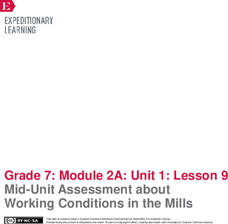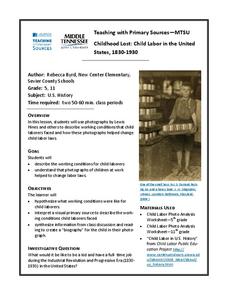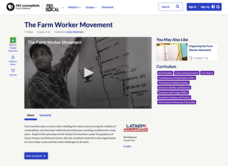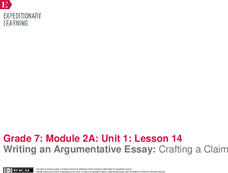Working Conditions Teacher Resources
Hi, What do you want to do?
Find Working Conditions lesson plans and worksheets
Showing 548 resources
Lesson Planet Curated
Becoming Us: Resistance
The three case studies in the Becoming Us: Resistance unit module look at the individuals and groups who have resisted the antidemocratic forces of inequality and oppression. The Fighting For Freedom resource has young historians...
Lesson Planet Curated
Latinx Rights in 1960s California
The two lessons in the Latinx Rights in 1960s California unit module examine two protests: The East LA school walkouts and the California grape workers strike of 1965-66. The East LA School walkouts lesson plan looks at the importance of...
Lesson Planet Curated
Crash Course: Economics
Nudge Theory, Game Theory, and Oligopoly? A 35-part video Crash Course goes beyond supply and demand and provides young economists with everything they need to know about economics. Based on the 2015 AP Economics guidelines, the...
EngageNY
Analyzing Textual Evidence: Working Conditions in the Mills
Deafening, dusty, debris. Such were the working conditions in the 1800s textile industry as portrayed in Katherine Paterson's novel Lyddie. Scholars watch a short video clip about life and work in the mills. Next, they work...
EngageNY
Introducing Working Conditions in the Mills
Scholars discover how working in a textile mill in the nineteenth century affected the title character from Katherine Paterson's novel, Lyddie. Partners analyze quotes from the novel and then add evidence and questions about...
Curated OER
Labor Unions and Working Conditions:United We Stand
Students examine primary documents about the establishment of labor unions. In this organized labor lesson, students research the working conditions that contributed to the growth of the labor union movement. Students make classroom...
EngageNY
Setting Purpose for Research: What are Fair Working Conditions?
Life may not be fair but working conditions should be. Scholars research working conditions at Wegmans by studying the company website. They complete a working conditions anchor chart and discuss their findings in a think-pair-share...
EngageNY
Introducing Module 2: Working Conditions—Then and Now
Let's get visual! Scholars embark on a gallery walk around the classroom to view quotes, images, and videos about historical and modern working conditions in various professions. They consider how working conditions have changed over...
EngageNY
Analyzing Word Choice: Understanding Working Conditions in the Mills
Ravenous or hungry, happy or ecstatic—why does word choice matter? Scholars continue to analyze working conditions in the mill and how the conditions affect the protagonist of Katherine Paterson's novel, Lyddie. They engage in a close...
EngageNY
Mid-Unit Assessment about Working Conditions in the Mills
Pupils demonstrate their knowledge of how setting impacts character development by completing a mid-unit assessment based on Katherine Paterson's novel Lyddie. They answer multiple-choice questions and cite textual evidence to...
Curated OER
Childhood Lost: Child Labor in the United States, 1830-1930
Working in groups, middle and high schoolers describe and discuss photographs depicting working conditions experienced by child laborers in the 19th century. They then write a persuasive paragraph supporting an amendment to regulate the...
Curated OER
The Industrial Age in America: Sweatshops, Steel Mills, and Factories
Students investigate the working conditions during the Age of Industrialization. They research how workers reacted to the conditions and discuss the results of labor movement.
DocsTeach
Lewis Hine Shedding Light on Child Labor through Photographs
The Industrial Revolution: long hours, low pay, and unsafe conditions. An eye-opening activity explores the darker side of industry and exposes the realities of child labor with photos. Scholars view four photos from the famous...
Curated OER
Industrial Revolution
Students cite the importance of the steam engine, cotton gin and steel making process. They describe conditions in cities due to increased industrialization. They explain how the living and working conditions led to the development of...
Smithsonian Institution
Strength in Solidarity: Coalition of Immokalee Workers and the Campaign for Fair Food
Not all food is created equal. The lesson dives into the world of migrant farm workers to show their struggles to earn livable wages and better working conditions. Academics learn why the Coalition of Immokalee Workers was created and...
EngageNY
Speech Structure: Part 2 of the Commonwealth Club Address
Scholars continue reading and analyzing César Chávez's 1984 speech, "Address to the Commonwealth Club of California." Working with partners, they answer text-dependent questions about how governments and consumers affect working...
PBS
The Farm Worker Movement
An impactful video details the work of Cesar Chavez and Dolores Huerta in creating the United Farmworkers. In the 1960s farm workers of California stood together to better their working conditions. Making their way to Sacramento,...
EngageNY
Analyzing Character: Who is Lyddie?
Character analysis can help readers feel more connected to a literary text. Scholars explore the topic by writing an acrostic poem about the main character from Katherine Paterson's novel, Lyddie. Then, pupils watch a short video to help...
EngageNY
Framing Lyddie’s Decision and Practicing Evidence Based Claims
Scholars grapple with whether the title character of Katherine Paterson's novel, Lyddie, should sign a petition about working conditions at the factory. They engage in close reading and discussion before adding their thinking about the...
EngageNY
Writing an Argumentative Essay: Crafting a Claim
As scholars prepare to craft their essays based on Katherine Paterson's Lyddie, they learn about using compelling reasons in their writing. Next, they develop a claim about whether Lyddie should sign a petition to speak out against...
EngageNY
Reading Closely: Introducing Chávez’s Commonwealth Club Address and Considering the Plight of the Farmworker
How can a persuasive speech help inspire social change? Scholars read along as they listen to the first half of César Chávez's 1984 speech, "Commonwealth Club Address." Next, pupils use graphic organizers to analyze one of Chávez's...
C-SPAN
On This Day: Triangle Shirtwaist Factory Fire
How did the Triangle Shirtwaist Factory Fire change modern working conditions? The engaging resource explains conditions that contributed to the tragic fire, the workers affected by it, and how it changed labor laws and working...
University of Wisconsin
Why Did the Triangle Fire Occur?
An investigation of the 1911 New York City Triangle Shirtwaist Factory fire leads class members to examine primary and secondary source materials related to the event and apply what they learn about the working conditions at the time to...
EngageNY
Grade 9 ELA Module 4, Unit 1, Lesson 20
After comparing the working conditions of the enslaved people to those of the Indian indentured workers on the sugar plantations, class members examine the conditions and the actions of specific historical figures that Marc Aronson and...























